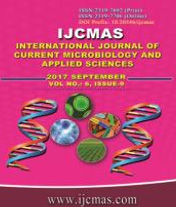


 National Academy of Agricultural Sciences (NAAS)
National Academy of Agricultural Sciences (NAAS)

|
PRINT ISSN : 2319-7692
Online ISSN : 2319-7706 Issues : 12 per year Publisher : Excellent Publishers Email : editorijcmas@gmail.com / submit@ijcmas.com Editor-in-chief: Dr.M.Prakash Index Copernicus ICV 2018: 95.39 NAAS RATING 2020: 5.38 |
The field experiment was conducted during the rabi season of 2014-15 at Student’s Research Farm Punjab Agricultural University, Ludhiana, Punjab. The experiment was laid out in factorial randomized block design (RBD) with 9 treatments have three planting techniques viz. unidirectional (UD), bidirectional (BD), broadcast (BC) and three cutting practices viz. uncut (UNC), cut at 50 days after sowing (C50 DAS) and cut at 60 DAS (C60 DAS) with four replications. The emergence, plant height, leaf area index, tillers and dry matter accumulation in bidirectional and uncut treatments was significant. Lodging score was significantly reduced by cutting practices (0%) as compared to uncut (57.27%) treatments. The effective tillers, spike length, test weight, grain (44.60 q ha-1) and biological yield (121.38 q ha-1) were significantly higher in bidirectional planting techniques and uncut treatments. The grain protein was higher recorded in uncut (10.55%) treatment. The net return with economic efficiency was significantly higher in bidirectional planting techniques (53,777 ₹ ha-1 and 324.84 ₹ day-1 ha-1) where as in cutting practices cut at 50DAS (55,756 ₹ ha-1) was found to be significant superior then cut at 60DAS and uncut.
 |
 |
 |
 |
 |